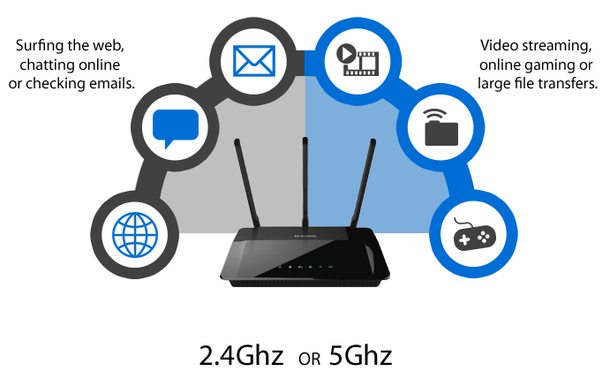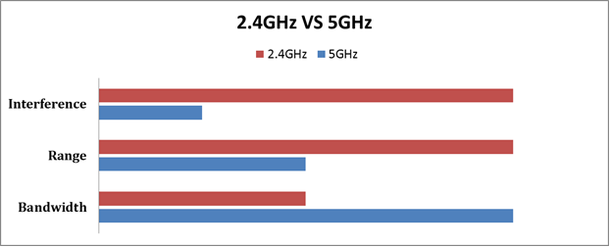A young man enters a restaurant and sits at a table. The waitress comes around and he asks for the Wi-Fi password. You must be familiar with the scene. Yes, not only you and me, almost everybody seems to do so. It has become a common phenomenon that when we plan to stay for a while in a store or restaurant, the first thing we do is to ask for the Wi-Fi password. Wireless network really makes it convenient to get access to the network, because you do not need ethernet network cable. We know that wireless network utilizes either 2.4 GHz frequency band or 5 GHz frequency band. From the time perspective, 2.4 GHz band was first used in 1999 while 5 GHz band was first available in 2007. Is 5 GHz wireless network better than 2.4 GHz wireless network in all aspects? The answer is no. Keep reading and you will see why.

We know that the Wi-Fi range refers to the coverage area of an access point’s Wi-Fi signal. The higher the frequency of a wireless signal, the smaller its range. As a result, 2.4 GHz wireless network covers a larger range than 5 GHz wireless network. And in practical applications, both 2.4 GHz and 5 GHz signals do not penetrate solid objects which limit their reach inside home. Therefore, from the perspective of the coverage area, 2.4 GHz wireless network performs better than 5 GHz wireless network.
As a matter of fact, the Wi-Fi speed only partially relates to the frequency band of wireless signal. For example, the newer 802.11g network running at 2.4 GHz can offer the same maximum data rate of 54 Mbps as the old 802.11a network running at 5 GHz. Apart from this, when the electric power is maintained at a low level, 2.4 GHz wireless network is able to carry more data than 5 GHz wireless network. For example, with the use of a pair of radios instead of one and increasing capacity in the good condition, some old 2.4 GHz 802.11g network devices match and even exceed the potential speed advantage of some 5 GHz 802.11a network devices. However, for those home devices that generate or consume the largest amount of network traffic, 5 GHz band can provides faster speed.
The 2.4 GHz frequency band is commonly used in consumer products while 5 GHz is not. In wireless home network, you may find that many older Wi-Fi devices do not support 5 GHz band, such as cordless phones, automatic garage door openers and other home appliances. Therefore, connecting the devices to 2.4 GHz band in any case is secure.
The 5 GHz router generally costs more than router which supports 2.4 GHz only, because 5 GHz router is comparatively new. But this does mean 5 GHz network technology is newer than 2.4 GHz. Generally speaking, both 2.4 GHz and 5 GHz have existed for a long time, but 2.4 GHz router is more common in wireless network applications.

From the above comparison, we can make a conclusion that 2.4 GHz and 5 GHz have their own advantages, or we can say that 2.4 GHz is better than 5 GHz in some aspects, such as Wi-Fi interference, Wi-Fi range and cost. In practical application, you have to make the selection according to your specific requirement. Now, on the market, dual band router is available which supports both 2.4 GHz and 5 GHz channels. FS.COM can also provide quality network patch cable and wireless access point for wireless network deployment.
Write a comment
zbdrariI (Monday, 19 July 2021 19:08)
20
QlqzzNwr (Sunday, 21 November 2021 10:41)
20
fnfOzvSR (Saturday, 05 March 2022 12:31)
20